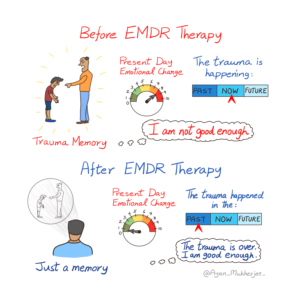
What is EMDR therapy?
EMDR stands for "Eye Movement Desensitization and Reprocessing." EMDR is an integrated, 8-phase therapeutic approach that consider's a person's somatic (physical) and emotional states, with a focus on how the brain perceives events.
EMDR was founded in 1987 by Francine Shapiro and is currently one of the most researched methods of contemporary psychotherapy. EMDR has been empirically proven to be particularly effective in treating PTSD and other types of traumas.
Key Features of EMDR
- Present-focused therapy, with particular interest in the ways past memories activate emotions in the present moment.
- Therapist guides client in accessing memories in order to move them from a place of emotional activation to a more logical, rational place, so that triggers of the past no longer have the same charge.
- Includes a technique called "bilateral stimulation," where a therapist will guide a client through eye movements, tones or tapping.
What to Expect
During the EMDR process, different emotions and sensations may arise as your brain works to make sense of things. You will be asked to notice your experience and give honest feedback. Whatever you are feeling in the moment is okay and my role as the therapist is to gently guide the process by observing and being curious.
Length of Treatment
It is my goal as a therapist to move clients through treatment swiftly, while at the same time, respecting the desired pace of the patient and EMDR process.
In my experience, the typical range for length of treatment is four to twelve weekly sessions, however, no two people are alike and the exact number of sessions will vary. Certain issues like a single traumatic event (ex., car accident) may take a shorter number of sessions than a more complex trauma history.
Have more questions?
If you have any questions, please contact me and I would be happy to talk with you about it.